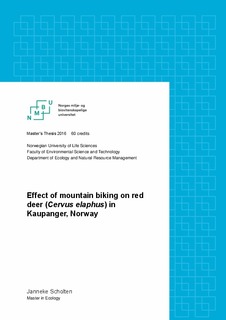Effect of mountain biking on red deer (Cervus elaphus) in Kaupanger, Norway
| dc.contributor.advisor | Moe, Stein Ragnar | |
| dc.contributor.advisor | Hegland, Stein Joar | |
| dc.contributor.author | Scholten, Janneke | |
| dc.date.accessioned | 2016-08-31T13:32:02Z | |
| dc.date.available | 2016-08-31T13:32:02Z | |
| dc.date.issued | 2016-08-31 | |
| dc.identifier.uri | http://hdl.handle.net/11250/2403205 | |
| dc.description.abstract | Human outdoor activities, like mountain biking, often affect animal behaviour. Ungulates might avoid roads and trails, and increase their avoidance with increasing human activity. Recently, biking on forest trails has increased considerably in Norway, but we still have limited knowledge about how forest biking may affect wildlife. In this study, I used pellet group counts and camera traps to study the effect of biking trails on red deer occurrence in Kaupanger, Norway. Based on pellet group counts, red deer avoided biking trails up to 40 m. The camera trap data showed that there was a tendency of a decreased deer occurrence with increasing human activity (trail width) during the day. Furthermore, males reacted stronger to increasing human activity than females. My findings imply that mountain biking has an effect on red deer. A further increase in biking may result in a higher avoidance and, thus, less suitable habitat for red deer in the forest area. | nb_NO |
| dc.language.iso | eng | nb_NO |
| dc.publisher | Norwegian University of Life Sciences, Ås | |
| dc.subject | red deer | nb_NO |
| dc.subject | mountain biking | nb_NO |
| dc.subject | trail | nb_NO |
| dc.subject | avoidance | nb_NO |
| dc.subject | pellet group counting | nb_NO |
| dc.subject | camera trap | nb_NO |
| dc.subject | GLMM | nb_NO |
| dc.title | Effect of mountain biking on red deer (Cervus elaphus) in Kaupanger, Norway | nb_NO |
| dc.type | Master thesis | nb_NO |
| dc.subject.nsi | VDP::Mathematics and natural science: 400::Zoology and botany: 480::Ecology: 488 | nb_NO |
| dc.source.pagenumber | 28 | nb_NO |
| dc.description.localcode | M-ECOL | nb_NO |
Tilhørende fil(er)
Denne innførselen finnes i følgende samling(er)
-
Master's theses (INA) [593]
